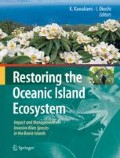Abstract
There are many endemic species in the Japanese Ogasawara Islands. However, many of these endemic species are likely to disappear as a result of reduction of habitat and the introduction of exotic species. Odonates are included within this category of species at risk. If the decrease in endemic odonates is due to a decrease in aquatic habitat, we have only to provide arti” flcial ponds to conserve these species. In this study, we provided artificial ponds as a habitat for odonates in Chichi-jima and Ani-jima, Ogasawara Islands. We then examined the possibility of protection and enhancement of odonate populations. Endemic odonates were found in the natural ponds of Ani-jima and Ototo-jima. In Ani-jima, they could be collected both in the artificial and natural ponds. The artificial pond could provide habitat for endemic odonates. However, in Chichi-jima, few odonates could be collected both in the artificial and natural ponds. Here, invasive species, such as Gambusia affinis and Anolis carolinensis, are found, which considered to prey upon odonate larvae and adults. Extermination of invasive species may be necessary to conserve the endemic odonates in Chichi-jima.
Reprinted from Yoshimura M, Okochi I (2005) Bulletin of FFPRI 4:45–51, with permission of FFPRI.
1) Kansai Research Center, Forestry and Forest Products Research Institute (FFPRI)
2) Department of Forest Entomology, Forestry and Forest Products Research Institute (FFPRI)
(Received on 20 March 2003, Accepted on 4 July 2003)
Access this chapter
Tax calculation will be finalised at checkout
Purchases are for personal use only
References
Asahina, S. (1952) Odonata of the Bonin Islands. Mushi, 23, 45–56.
Asahina, S. (1976) Notes on the dragonfly-fauna of the Bonin Island, North Pacific. Gekkan-mushi, 68, 17–20.
Goodsell, J. A. and Kats, L. B. (1999) Effect of introduced mosquitofish on pacific treefrogs and the role of alterendemic prey. Conserv. Biol, 13, 921–924.
Hasegawa, M. (1986) Ecological studies of the lizards on Chichi-jima, the Bonin Islands. Ogasawara Kenkyu Nenpo,9, 12–17.
Hirose, Y. (1993) Research of dragonflies from Ogasawara Islands, Tokyo, Japan. Gekkan-mushi, 269, 19–21.
Ishida, S. and Kijima, K. (1978) On the Dragonflies of Ogasawara Islands. Gensei, 33, 3–13.
Karube, H. (2001) On a critical situation of the endemic dragonflies from the Ogasawara Islands. Gekkan-mushi, 369, 22–32.
Karube, H. (2004) Outline of the present situation of the insects endemic to the Ogasawara Islands. Res. Rep. Kanagawa Prefect. Mus. Nat. Hist., 12, 13–16.
Karube, H. and Suda, S. (2004) Apreliminary report on influence of an introduced lizard Anolis carolinensis on the native insect fauna of Ogasawara Islands. Res. Rep. Kanagawa Prefect. Mus. Nat. Hist., 12, 21–30.
Makihara, H., Kitajima, H., Goto, H., Kato, T. and Makino, S. (2004) An evaluation of predation impact of the introduced lizard Anolis carolinensis on the endemic insect fauna of the Ogasawara Islands based on insect collection records and feeding experiments, with special reference to longicorn beetles (Insecta: Coleoptera: Cerambycidae). Bull. FFPRI, 3, 165–183.
Miyashita, K. (1991) Range expansion of green anole and habitat state of snake-eyed skink. In Ono, M., Kimura, M., Miyashita, K. and Nagoshi, M. (eds.) “ Report of the Second General Survey of Natural Environment of the Ogasawara (Bonin) Islands 2“, Tokyo Metropolitan University, Tokyo, 182–184.
Offill, Y. A. and Walton, W. E. (1999) Comparative efficacy of the threespine stickleback (Gasterosteus aculeatus) and the mosquitofish (Gambusia affinis) for mosquito control. J. Amer. Mosquito Control Assoc, 15, 380–390.
Oobayashi, T. (2001) Green anole attacking Meimuna boninensis. Cicada, 16, 1.
Ota, H., Kakazu, H. and Izawa, M. (1995) Discovery of breeding population of the green anole, Anolis carolinensis (Iguanidae: Squamate), from Okinawajima Island, Ryukyu Archipelago, Japan. Biol. Mag. Okinawa, 33, 27–30.
Rupp, H. R. (1996) Adverse assessments of Gambusia affinis: an alternate view for mosquito control practitioners. J. Amer. Mosquito Control Assoc, 12, 155–166.
Suzuki, A. and Nagoshi, M. (1999) Habitat utilization of the native lizard, Crypt obi ephar us boutoni nigropunctatus, in areas with and without the introduced lizard, Anolis carolinensis, on Hahajima, the Ogasawara Islands, Japan. In Ota, H. (ed.) “Tropical Islands, Herpetofauna: Origin, Current Diversity, and Conservation”, Elsevier Science, Amsterdam, 155–168.
Sword, G. A. (2001) Tasty on the outside, but toxic in the middle: grasshopper regurgitation and host plant-mediated toxicity to a vertebrate predator. Oecologia, 128,416–421.
Acknowledgments
We would like to thank to T. Oobayashi, for helping the collection of aquatic invertebrate. Collection of endemic and natural monumental odonatan species was done with the permission of Ogasawara broad of education, Tokyo Metropolis and the Agency for Cultural Affairs. This work was supported by a grant funded by the Japan Environmental Agency.
Author information
Authors and Affiliations
Corresponding author
Editor information
Editors and Affiliations
Rights and permissions
Copyright information
© 2010 Springer
About this chapter
Cite this chapter
Mayumi, Y., Isamu, O. (2010). A decrease in endemic odonates in the Ogasawara Islands, Japan. In: Kawakami, K., Okochi, I. (eds) Restoring the Oceanic Island Ecosystem. Springer, Tokyo. https://doi.org/10.1007/978-4-431-53859-2_21
Download citation
DOI: https://doi.org/10.1007/978-4-431-53859-2_21
Publisher Name: Springer, Tokyo
Print ISBN: 978-4-431-53858-5
Online ISBN: 978-4-431-53859-2
eBook Packages: Biomedical and Life SciencesBiomedical and Life Sciences (R0)

